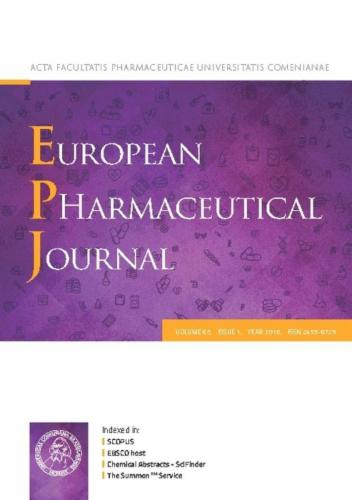Preparation and biological activity of isoperrottetin A and its phosphonium salts derivatives
IF 4.7
3区 医学
Q1 PHARMACOLOGY & PHARMACY
引用次数: 0
Abstract
Bacterial resistance to antibiotics in use represents a critical threat to public health. The treatment of nosocomial, often life-threatening infections is often challenging and requires the search for new antibacterial compounds. In this study a series of phosphonium salts derived from bis(bibenzyl) isoperrottetin A were studied. Bis(bibenzyls) are compounds unique for liverworts. Phosphonium salts were prepared by an eight-step synthesis. The key steps in its preparation were the Ullmann reaction and the Wittig reaction. Ten phosphonium salts were prepared. Isoperrottetin A and its phosphonium salts were tested for antibacterial activity. Some of the compounds exhibit significant biological activity. Most of the prepared derivatives are more potent than the original isoperrottetin A. Compounds were evaluated for the antibacterial activity against selected Gram-positive bacteria such as Staphylococcus aureus, methicillin sensitive and resistant, Enterococcus faecalis and vancomycin sensitive and resistant and Gram-negative bacteria such as Escherichia coli, Pseudomonas aeruginosa, and Klebsiella pneumoniae. Mycobacterium smegmatis and Mycobacterium marinum belonging to the genus Mycobacterium were also tested. Besides antibacterial activity, the compounds inhibit cell breathing and show cytotoxic activity against melanoma cells, retinal and epithelial cells. The results of antibacterial tests showed that the most effective compound is 5,5′,5′',5′''-[1,7(1),4,5(1,3)-tetrabenzenaoctaphane-13,44,56,83-tetrayltetrakis(oxy)]tetrakis(5-oxo-P,P,P-triphenylpentane-1-phosphonium) tetrabromide (4P). The values of minimum bactericidal concentration (MBC) against S. aureus methicillin sensitive and resistant and E. faecalis vancomycin sensitive and resistant were < 1 µM. At the same time, the compound does not involve damaging the cell wall, as is known for cationic amphiphilic compounds, and showed favorable safety profiles at MBC values. These findings highlight the potential of compounds found in liverworts as active agents against sensitive and resistant bacterial strains. Chemical modification of bis(bibenzyls) with a phosphonium cation is promising in preparation of potent microbicidal compounds.

异过钙蛋白A及其磷盐衍生物的制备及生物活性研究。
细菌对正在使用的抗生素产生耐药性是对公众健康的严重威胁。院内感染的治疗往往是具有挑战性的,需要寻找新的抗菌化合物。以双(联苯)异过黄素a为原料制备了一系列磷酸盐。双(联苯)是苔类植物特有的化合物。采用八步法合成了磷盐。其制备的关键步骤是Ullmann反应和Wittig反应。制备了10种磷酸盐。对异过黄素A及其磷盐进行了抑菌活性测定。其中一些化合物表现出显著的生物活性。化合物对革兰氏阳性菌(如金黄色葡萄球菌、甲氧西林敏感耐药菌、粪肠球菌和万古霉素敏感耐药菌)和革兰氏阴性菌(如大肠杆菌、铜绿假单胞菌和肺炎克雷伯菌)的抑菌活性进行了评价。还检测了属于分枝杆菌属的耻垢分枝杆菌和海洋分枝杆菌。除抗菌活性外,该化合物还抑制细胞呼吸,并对黑色素瘤细胞、视网膜和上皮细胞显示细胞毒性活性。抑菌试验结果表明,最有效的化合物为5,5′,5′,5′-[1,7(1),4,5(1,3)-四苯八烷-13,44,56,83-四基四烷(氧)]四烷(5-氧-P,P,P-三苯戊烷-1-磷)四溴化(4P)。对甲氧西林敏感耐药的金黄色葡萄球菌和对万古霉素敏感耐药的粪肠球菌的最低杀菌浓度(MBC)均< 1µM。与此同时,该化合物不会像阳离子两亲性化合物那样破坏细胞壁,并且在MBC值下显示出良好的安全性。这些发现强调了在苔类植物中发现的化合物作为对抗敏感和耐药菌株的活性剂的潜力。用磷离子对双(联苯)进行化学改性是制备强效杀微生物化合物的有效途径。
本文章由计算机程序翻译,如有差异,请以英文原文为准。
求助全文
约1分钟内获得全文
求助全文
来源期刊
CiteScore
9.60
自引率
2.20%
发文量
248
审稿时长
50 days
期刊介绍:
The journal publishes research articles, review articles and scientific commentaries on all aspects of the pharmaceutical sciences with emphasis on conceptual novelty and scientific quality. The Editors welcome articles in this multidisciplinary field, with a focus on topics relevant for drug discovery and development.
More specifically, the Journal publishes reports on medicinal chemistry, pharmacology, drug absorption and metabolism, pharmacokinetics and pharmacodynamics, pharmaceutical and biomedical analysis, drug delivery (including gene delivery), drug targeting, pharmaceutical technology, pharmaceutical biotechnology and clinical drug evaluation. The journal will typically not give priority to manuscripts focusing primarily on organic synthesis, natural products, adaptation of analytical approaches, or discussions pertaining to drug policy making.
Scientific commentaries and review articles are generally by invitation only or by consent of the Editors. Proceedings of scientific meetings may be published as special issues or supplements to the Journal.

 求助内容:
求助内容: 应助结果提醒方式:
应助结果提醒方式:


